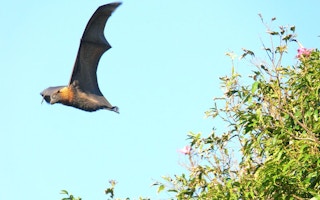Camera trap footage has shown, for the first time, that a threatened bat species in Malaysia is an important pollinator of durian trees (Durio zibethinus).
Past research in other parts of the world has shown that certain bats do pollinate durian trees, and insects may also play a role. But until now, scientists weren’t sure whether large fruit bats — known in Malaysia as “flying foxes” — were a help or a hindrance to durian trees’ production of fruit.
“When I saw all this incredible video footage from our camera traps, showing the flying foxes feeding on durian nectar without actually destroying the flowers, I was completely mind-blown,” said Sheema Abdul Aziz, a conservation ecologist and president of Rimba, a Malaysian conservation NGO, in an email.
“I had to really reassess my assumptions about these bats.”
Sheema led a team of researchers who set out to understand what impact these large-bodied bats might be having on such a critical staple of the local diet in Peninsular Malaysia.
Durian fruit, known for its pungent — and some might say off-putting — aroma, is adored by some for its taste. In many villages in Malaysia, locals tend to descendants of the naturally occurring, wild variety of the tree.
With the help of a group of expert climbers from the organization Tree Climbers Malaysia, Sheema and her colleagues installed 19 camera traps in four of these “semi-wild” durian trees.
They reported their findings online in September in the journal Ecology and Evolution.
Flying foxes have a bit of a bad reputation for being impeding the production of durian and other types of fruit trees, though there is little evidence that that’s the case. Farmers often worry that these bats might damage commercially valuable fruit like durian, casting the bats as pests and leading to efforts to eradicate them.
In some cases, governments have even authorized bat culls, Sheema said, “which can have a disastrous impact not just on the bats but also on the ecosystems that they help to shape and maintain.”
Hunting pressure, along with hunting for traditional Chinese medicine and some specialty restaurants, has led to a disconcerting drop in their numbers in Malaysia.
“
When I saw all this incredible video footage from our camera traps, showing the flying foxes feeding on durian nectar without actually destroying the flowers, I was completely mind-blown.
Sheema Abdul Aziz, conservation ecologist and president, Rimba
The IUCN lists the subject of this study, the island flying fox (Pteropus hypomelanus), as a species of Least Concern. But that broad designation doesn’t tell the whole story, Sheema said.
“This is based on global data, as this flying fox species is widely distributed,” she said. “This listing does not reflect the situation in Malaysia where flying foxes are in a much more precarious situation.”
At the same time, scientists don’t know much about how these bats fit into the ecosystem in this part of the world.
“I was surprised that so little research has been done on this in the Southeast Asian region, and that the role of flying foxes is so poorly understood,” Sheema said. “I really wanted to start investigating the interactions between flying foxes and plants, and the implications for human well-being.
Research in other places has indicated that bats aren’t as harmful as many people suppose, she said. In one unpublished study centering on fruit bats in Mauritius — which sanctioned a bat cull several years ago — scientists found that a related flying fox (P. niger) only damaged a small amount of fruit.
“More damage was actually caused by birds, wind, and failure to harvest fruits at the proper time,” she said.
Sheema had a hunch that flying foxes might instead be quite beneficial to durian production.
“These are such huge bats that can carry big fruits over long distances, so I was convinced that they must be playing an important ecological role in tropical ecosystems,” she said. What’s more, “The structure and size of durian flowers are perfectly suited to bat pollination.”
Sheema and her colleagues found that the durian flowers pollinated by flying foxes developed into healthy fruit.
“Some farmers actually blame bats for removing or destroying durian flowers and fruits, which they believe causes poorer fruit production,” she said. “Nothing could be further from the truth!”
Her team’s research, Sheema said, bolsters the case for protecting, rather than killing, flying foxes, as a drop in their numbers may impact how many durians a tree produces, or perhaps the size and taste of the fruit.
“It’s possible that both quantity and quality may be affected by bat declines,” she said. “But we don’t know for sure yet. This is definitely something that I’m hoping to find out by doing more studies on durian pollination ecology.”
This story was published with permission from Mongabay.com.










